-
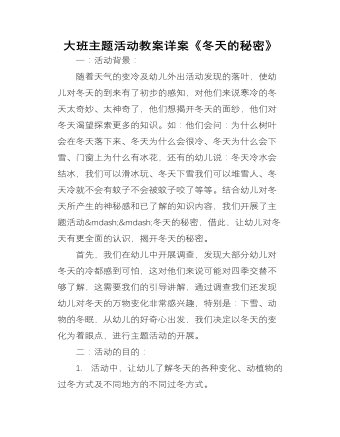
《冬天的秘密》主题活动教案
一:活动背景: 随着天气的变冷及幼儿外出活动发现的落叶,使幼儿对冬天的到来有了初步的感知,对他们来说寒冷的冬天太奇妙、太神奇了,他们想揭开冬天的面纱,他们对冬天渴望探索更多的知识。如:他们会问:为什么树叶会在冬天落下来、冬天为什么会很冷、冬天为什么会下雪、门窗上为什么有冰花,还有的幼儿说:冬天冷水会结冰,我们可以滑冰玩、冬天下雪我们可以堆雪人、冬天冷就不会有蚊子不会被蚊子咬了等等。结合幼儿对冬天所产生的神秘感和已了解的知识内容,我们开展了主题活动——冬天的秘密,借此,让幼儿对冬天有更全面的认识,揭开冬天的秘密。 首先,我们在幼儿中开展调查,发现大部分幼儿对冬天的冷都感到可怕,这对他们来说可能对四季交替不够了解,这需要我们的引导讲解,通过调查我们还发现幼儿对冬天的万物变化非常感兴趣,特别是:下雪、动物的冬眠,从幼儿的好奇心出发,我们决定以冬天的变化为着眼点,进行主题活动的开展。 二:活动的目的: 1. 活动中,让幼儿了解冬天的各种变化、动植物的过冬方式及不同地方的不同过冬方式。 2. 冬天的活动及冬天的节日,使幼儿对冬天由更进一步的了解,从而对冬天有更深的认识。 三;主题活动网络图: 昼长夜短 寒冷 雪花、冰雹 变化 的冬季 冬眠、南迁、躲 天气 现象 不同地方 储备食物、冬眠、 圣诞节、元旦、春节 冬天的景色 过冬方式 冬天的节日 冬天的秘密 动物 动物趣闻 冬天的活动 植物人类的变化 衣服的变化 蔬菜、庄稼 跳绳、堆雪人 制作漂亮 树、花 食物 疾病 取暖 天冷我不怕 踢毽子 的冬装 常绿树、落叶树 预防感冒 树叶找家 注: 为教师预设内容、 师生共同生成、 为幼儿生成
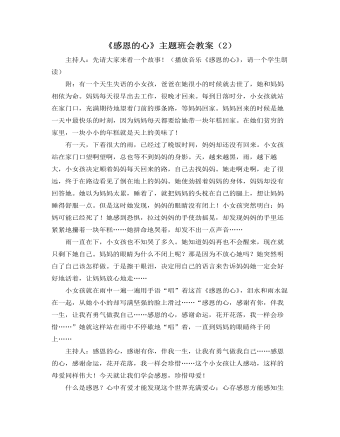
《感恩的心》主题班会教案(2)
服刑的儿子接过这堆葵花子仁,手开始抖。母亲亦无言无语,撩起衣襟拭眼。她千里迢迢探望儿子,卖掉了鸡蛋和小猪崽,还要节省多少开支才凑足路费。来前,在白天的劳碌后,晚上再在煤油灯下嗑瓜子。嗑好的瓜子仁放在一起,看它们像小山一点点增多,没有一粒舍得自己吃。十多斤瓜子嗑亮了许多夜晚。服刑的儿子垂着头。作为身强力壮的小伙子,正应是奉养母亲的时候,他却不能。在所有探监的人当中,他母亲的衣着是最褴褛的。母亲一口一口嗑的瓜子,包含千言万语。儿子“扑通”给母亲跪下,他忏悔了。一次,同龄的朋友对我抱怨起母亲,说她没文化思想不开通,说她什么也干不了还爱唠叨。于是,我就把这两个故事讲给他听。听毕,他泪眼朦胧,半晌无语。
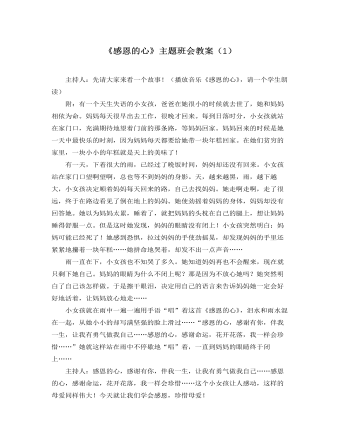
《感恩的心》主题班会教案(1)
主持人:然而我们又是怎样对待我们的父母的呢?下面我们来做个调查?你是否了解你的妈妈?1、你妈妈的生日是_________。2、你妈妈的体重是_________。3、你妈妈的身高是________。4、你妈妈穿_______码鞋。5、你妈妈喜欢颜色是________。6、你妈妈喜欢水果是________。7、你妈妈喜欢的花是________。8、你妈妈喜欢的日常消遣活动是_____________。请你如实回答。把你的答案写在一张纸寄给你妈妈评分答对6题以下的请你以后多与妈妈沟通。主持人:其实值得感恩的不仅仅我们的母亲,我们对父亲、师长、亲朋、同学、社会等等都应始终抱有感恩之心。我们的生命、健康、财富以及我们每天享受着的空气阳光水源,都应该在我们的感恩之列。一位盲人曾经请人在自己的乞讨用的牌子上这样写道:“春天来了,而我却看不到她。”我们与这位盲人相比,进一步说与那些失去生命和自由的人相比,目前能这样快快乐乐地活在世界上,谁说不是一种命运的恩赐,我们还会时常愤怒得发抖而总去抱怨命运给自己的不幸和不平吗?
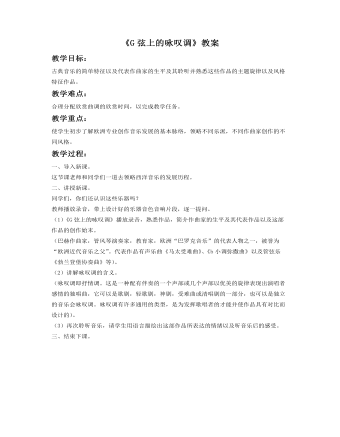
《G弦上的咏叹调》教案
教学过程:一、导入新课。这节课老师和同学们一道去领略西洋音乐的发展历程。二、讲授新课。同学们,你们还认识这些乐器吗?教师播放录音,带上设计好的乐器音色音响片段,逐一提问。(1)《G弦上的咏叹调》播放录音,熟悉作品,简介作曲家的生平及其代表作品以及这部作品的创作始末。(巴赫作曲家,管风琴演奏家,教育家,欧洲“巴罗克音乐”的代表人物之一,被誉为“欧洲近代音乐之父”。代表作品有声乐曲《马太受难曲》、《b小调弥撒曲》以及管弦乐《勃兰登堡协奏曲》等)。
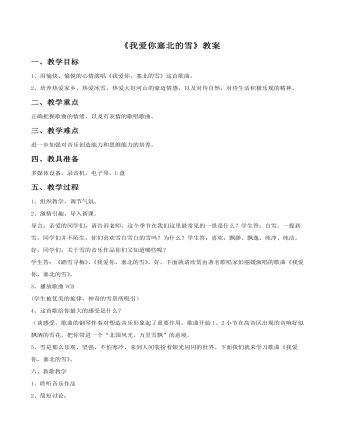
《我爱你塞北的雪》教案
教学过程1、组织教学,调节气氛。2、激情引趣、导入新课。导言:亲爱的同学们,请告诉老师,这个季节在我们这里最常见的一景是什么?学生答:白雪。一提到雪,同学们并不陌生,你们喜欢雪白雪白的雪吗?为什么?学生答:喜欢,飘渺、飘逸、纯净、纯洁。好,同学们,关于雪的音乐作品你们又知道哪些呢?学生答:《踏雪寻梅》、《我爱你,塞北的雪》。好,下面就请欣赏由著名歌唱家彭丽媛演唱的歌曲《我爱你,塞北的雪》。3、播放歌曲VCD(学生被优美的旋律,神奇的雪景所吸引)4、这首歌给你最大的感受是什么?(谈感受,歌曲的钢琴伴奏对塑造音乐形象起了重要作用,歌曲开始1、2小节在高音区出现的音响好似飘洒的雪花,把你带进一个“北国风光,万里雪飘”的意境。5、雪是那么乐观、坚强、不怕寒冷,来到人间装扮着银光闪闪的世界。下面我们就来学习歌曲《我爱你,塞北的雪》。六、新歌教学1、聆听音乐作品2、简短讨论:(1) 歌曲的速度怎样?(2) 应该用怎样的情绪演唱?
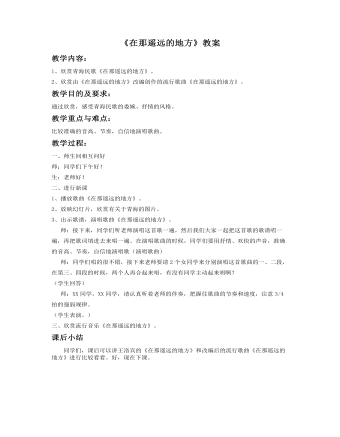
《在那遥远的地方》教案
教学过程:一、师生间相互问好师:同学们下午好!生:老师好!二、进行新课 1、播放歌曲《在那遥远的地方》。2、放映幻灯片,欣赏有关于青海的图片。3、出示歌谱,演唱歌曲《在那遥远的地方》。 师:接下来,同学们听老师演唱这首歌一遍,然后我们大家一起把这首歌的歌谱唱一遍,再把歌词填进去来唱一遍。在演唱歌曲的时候,同学们要用抒情、欢快的声音,准确的音高、节奏,自信地演唱歌(演唱歌曲) 师:同学们唱的很不错,接下来老师要请2个女同学来分别演唱这首歌曲的一、二段,在第三、四段的时候,两个人再合起来唱,有没有同学主动起来唱啊?(学生回答) 师:XX同学,XX同学,请认真听着老师的伴奏,把握住歌曲的节奏和速度,注意3/4拍的强弱规律。(学生表演。)三、欣赏流行音乐《在那遥远的地方》。
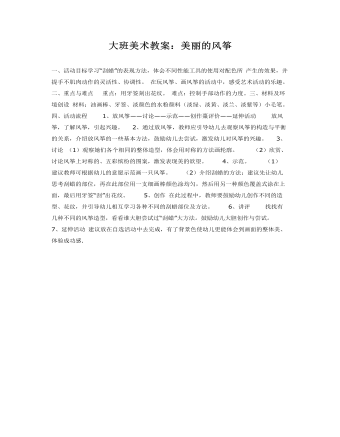
大班美术教案:美丽的风筝
二、重点与难点 重点:用牙签刻出花纹。难点:控制手部动作的力度。三、材料及环境创设材料:油画棒、牙签、淡颜色的水粉颜料(淡绿、淡黄、淡兰、淡紫等)小毛笔。 四、活动流程1、放风筝——讨论——示范——创作棗评价——延伸活动 放风筝,了解风筝,引起兴趣。2、通过放风筝,教师应引导幼儿去观察风筝的构造与平衡的关系,介绍放风筝的一些基本方法,鼓励幼儿去尝试,激发幼儿对风筝的兴趣。3、讨论(1)观察她们各个相同的整体造型,体会用对称的方法画轮廓。

大班美术教案:美丽的春天
2、引导幼儿用学过的花纹、创作花纹,装饰纸袋,要求色彩鲜艳。3、培养幼儿的发散性思维能力和审美能力。活动准备:纸袋样品、制作图解、挂历纸、剪刀、胶棒、油画棒、粘画活动过程:1、欣赏美丽的春天风光,感受家乡的美丽。2、激发幼儿爱家乡爱聊城的情感,让家乡的春天更美丽,启迪幼儿环保意识。3、如何使家乡更美丽?
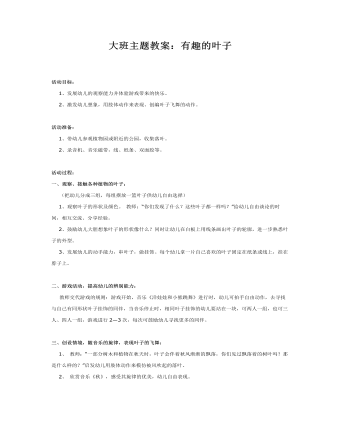
大班主题教案:有趣的叶子
活动准备: 1、带幼儿参观植物园或附近的公园,收集落叶。 2、录音机、音乐磁带,线、纸条、双面胶等。 活动过程: 一、观察、接触各种植物的叶子: (把幼儿分成三组,每组摆放一篮叶子供幼儿自由选择) 1、观察叶子的形状及颜色。教师:“你们发现了什么?这些叶子都一样吗?”给幼儿自由谈论的时间,相互交流、分享经验。 2、鼓励幼儿大胆想象叶子的形状像什么?同时让幼儿在白板上用线条画出叶子的轮廓,进一步熟悉叶子的外型。 3、发展幼儿的动手能力,串叶子,做挂饰。每个幼儿拿一片自己喜欢的叶子固定在纸条或线上,挂在脖子上。
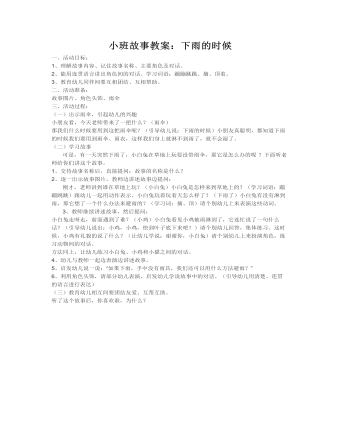
小班故事教案:下雨的时候
2、能用连贯语言讲出角色间的对话。学习词语:蹦蹦跳跳、摘、顶着。 3、教育幼儿同伴间要互相团结、互相帮助。 二、活动准备: 故事图片、角色头饰、雨伞 三、活动过程: (一)出示雨伞,引起幼儿的兴趣 小朋友看,今天老师带来了一把什么?(雨伞) 那我们什么时候要用到这把雨伞呢?(引导幼儿说:下雨的时候)小朋友真聪明,都知道下雨的时候我们要用到雨伞、雨衣,这样我们身上就淋不到雨了,就不会湿了。 (二)学习故事 可是,有一天突然下雨了,小白兔在草地上玩耍没带雨伞,那它是怎么办的呢 ?下面听老师给你们讲这个故事。 1、交待故事名称后,直接提问:故事的名称是什么?
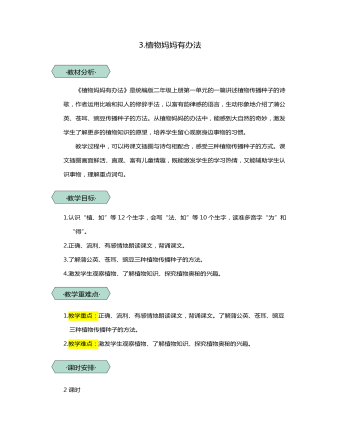
统编版二年级语文上第3课植物妈妈有办法教学设计教案
《植物妈妈有办法》是统编版二年级上册第一单元的一篇讲述植物传播种子的诗歌,作者运用比喻和拟人的修辞手法,以富有韵律感的语言,生动形象地介绍了蒲公英、苍耳、豌豆传播种子的方法。从植物妈妈的办法中,能感到大自然的奇妙,激发学生了解更多的植物知识的愿望,培养学生留心观察身边事物的习惯。教学过程中,可以将课文插图与诗句相配合,感受三种植物传播种子的方式。课文插图画面鲜活、直观、富有儿童情趣,既能激发学生的学习热情,又能辅助学生认识事物,理解重点词句。 1.认识“植、如”等12个生字,会写“法、如”等10个生字,读准多音字“为”和“得”。2.正确、流利、有感情地朗读课文,背诵课文。3.了解蒲公英、苍耳、豌豆三种植物传播种子的方法。4.激发学生观察植物、了解植物知识、探究植物奥秘的兴趣。 1.教学重点:正确、流利、有感情地朗读课文,背诵课文。了解蒲公英、苍耳、豌豆三种植物传播种子的方法。2.教学难点:激发学生观察植物、了解植物知识、探究植物奥秘的兴趣。 2课时
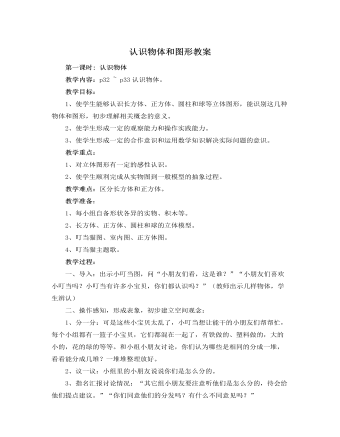
人教版新课标小学数学一年级上册认识物体和图形教案
1.让学生拿出长方体摸一摸,问:你有什么感觉?摸的的面是什么形状?师:谁来摸一摸,老师手上长方体的长方形在哪?(学生找出长方形)2.让学生在自己的学具(长方体、正方体、圆柱体)上找图形,并和小组里的同学说一说。3、指名说,教师把学生找到的图形从立体图形上分离出来,贴于黑板上,师:这些图形是物体上的一个面,这就是我们今天要认识的图形。(板书课题——认识平面图形)4.让学生说说:从什么物体上找到了什么图形?5.师:你能想办法把这些形状画到一张纸上吗?请学生演示各自不同的方法,然后教师在黑板上沿长方体的一个面画出长方形。师:你会画吗?请小朋友们用自己喜欢的办法画出并剪出长方形、正方形、圆和三角形各2个。

人教版新目标初中英语八年级上册Can you come to my party教案3篇
Step 3 (3b)First, tell the students when we talk about our future plans, we often use: I’m+verb+ing When we talk about what we must do, we use have to. Ask the students to fill in the blanks in 3b. The answers are: shopping, go to see, a test, I’m going, my family. Step 4 (3c)Let the students write an e-mail message to a friend. Say why you can’t visit next. Before the exercise, ask the students to give some possible answers and write them on the blackboard. So the students will feel easy to finish the writing exercise. After they finish it, Let them to correct it in groups first. Each group chooses theirs best one to read in front of the whole class. Step 5 ( planning a party )First read the conversation in the box together. Then ask the students to turn to page 88.Write down everything you have to do next week. Write in all the things you have to do . Ask the students to look at the list. Ask them “What day are you free?” This is when you can have your party. Step 6 (Self check 1 )Let the students to fill in the blanks with the words given. Change the forms of the words if possible. Then make their own sentences. The answers are: visit, playing, have to, study, comeStep 7 (Self check 2)Imagine you are Marie. Read the information and look at your schedule. Write replies to the invitation.

人教版新目标初中英语八年级上册How do you make a banana milk shake教案2篇
1. First, ... then, ... next, ... finally, ...首先,……然后,……接着,……最后,……这是英语中表达做某事的步骤的一种说法。如果步骤较多,还可以说:first-next-after that-later on-finally/at last通常你会听到说英语国家的人在说 first, next, then, finally 和后面的内容时,他们会做一些停顿。这样就能提前告诉听者接下来讲的是一系列的步骤。这一点在朗读和听力中应特别注意。2. how many, how much均为疑问词,同是“多少”,但用法不同。请看:how many修饰可数名词复数,how much修饰不可数名词。但在用法上,同学们常犯如下错误:1) [误] How many are there bananas on the table?[正] How many bananas are there on the table?[析] how many, how much 中的many,much是形容词,常修饰名词作定语,故后面跟名词。2) [误]How much tea are there on the table?[正]How much tea is there on the table?[析] how much修饰不可数名词时,谓语动词用单数。how many与how much的区别可简记为:前how many:问“多少”,复数名词后面跑;how much问“多少”,不可数名词单数好。前者答语用基数词,后者答语用数量关系。

人教版新目标初中英语八年级上册How was your school trip教案2篇
“Go for it!” is based on “Task-Based Language Teaching”. It adheres to “The authenticity principle”, “The form-function principle”, “The task dependency principle” and “The principle of learning by doing”. These principles all accord with the demands of curriculum focus.In and of Grade Seven (II), “Go for it!”, students have learned “The Simple Past Tense”. And it appears again in of Grade Eight (I). teaches students more about how to talk about events in the past. In addition, it gives affirmative and negative statements in the past tense, such as the sentence patterns “Did you see …?” “Were there …?” “Did you go …?” As the first part of Unit 8, Section A opens with a picture presenting the last school trip in the aquarium and continues with several step-by-step practice activities, which are all good for students to master “The Simple Past Tense”. Doing well in Section A will help students integrate the new target language with that in Section B. Thus, they can describe the events in the past freely and foster their own ability of reflecting and practicing. II. Teaching ObjectivesTeaching objective is the beginning and aim of teaching activities. According to the overall goal of the English elementary course--- improve students' synthetic ability of language application, which should be based on the development of students’ “Language knowledge”, “Language skills”, “Character building”, “Learning strategies” and “Cross-cultural awareness”. The teaching objectives are described as follows(I). Knowledge objectivesi. Master the simple past tense of regular and irregular verbsii. Recite the new words and expressions about the last school trip in the aquarium, including their pronunciation and intonation

人教版新目标初中英语八年级上册Could you please clean your room教案3篇
一、 教学内容Section A 1a----1c二、 教学目标1.学习词汇do the dishes, make the bed, take out the trash, fold the clothes, do the laundry, sweep the floor, clean the living room.2.句型 Could you please clean your room? Yes, sure.三、 教学准备 学生预习本单元所有的词汇多媒体课件 活动表 奖品四、 教学过程Pre-task1. Warming upEnjoy ourselves. Watch cartoon Cinderella. 看动画片段《灰姑娘》导如入本课话题和新词汇“chores”美丽善良的鬼姑娘因继母的嫉妒,每天得做所有的家务。片段的主题使学生联想到本课的话题。2. learn new words and phrasesLook! What is she / he dong? 看图学习动词词组do chores, do the dishes, make the bed, take out the trash, fold the clothes, do the laundry, clean the living room.3. Guessing game.What is she doing ? 4. Pair work. 1a, Do you do these things at home? Write “Y” for “yes” and “N” for “no”.5. Listening . 1b , Peter’s chores or Mom’s chores?理解目标语Could you please clean your room? Yes, sure.Write “M” for Mom’s chores, “P” for Peter’s chores in the chart.6. PairworkLook at the picture,Ask your partner to do the chores that you see. 7. Interview Who is the most able at home? 1) What chores do you do at home? How often do you do the chores? Work in four, interview each of the students in the group, fill in the chart.

人教版新目标初中英语八年级上册How do you get to school教案2篇
Step Ⅶ Role play ( Work on 1b)1. First ask two students to read the dialogue to the class.Sa: How do you get to school?Sb: Well, I ride my bike to the subway station. Then I take the subway.2. Now work with a partner.Suppose you use two kinds of transportation to get to school \Hangzhou\Beijing... (bus, train, subway, walking, bike, etc.) Tell how you get there. You may use the phrases in 1a.3. Then ask different pairs of students to present their conversations to the class.Step ⅧListening1. Work on 2a(1) First ask students to read the list of information that Thomas wants to know.…where Nina lives.…how far from school she lives.…how long it takes to get to school.…how she gets to school.…what she thinks of the transportation.(2) Tell students what transportation and bus stop mean.bus stop 汽车站 transportation n. 运送;运输Then tell students we'll hear a recording. Please put a checkmark in front of each thing that Thomas wants to know.(3) Now play the recording for students.( Have students pay attention to the sample answer.) (4) Then correct the answers.

人教版新目标初中英语八年级上册What are you doing for vacation教案2篇
Teaching goals : 1. Words & phrases: babysit ,get back , fishing , rent , think about , decide(on) , tourist etc. 2. How to talk about future plans . 3. 现在进行时表示将来计划或行动. 4. 特殊疑问句(where , when , how long引导) Important and difficult points : Drills :What are you doing for vacation ? I’m watching TV . When are you going ? I’m going … . How long are you staying ? We’re staying for five days . Teaching aids : cards and a tape ,a large wall calendar . Period 1 Teaching procedures : Step 1Leading in1. Free talk . 2. Put up the wall calendar . T: I’m staying home on Saturday (pointing to next Saturday ).Ss repeat . Ss: I’m staying home on Saturday . T: OK. Today we’ll learn how to talk about future plans. Step 2Pre-task SB Page 13 , 1a . 1. Look at the picture carefully and tell what you see in the picture . 2. Write the activities from the pictures in the box and add some more . 3. Practice reading . Step 3While-task1. Using the activities we write in 1a to make conversations .For example :What are you doing for vacation ? I’m visiting my uncle . 2. Pairwork .Practice in pairs . 3. 用第三人称练习对话.

人教版新目标初中英语八年级上册I’m going to be a basketball player教案3篇
教学目标1.知识目标:(1)学习What are you going to be when you grow up?/How are you going to do that?句式。(2)学会用英语描述有关职业的表达法。2.能力目标:(1)能够谈论为实现理想所做出的打算和安排。(2)能够谈论未来自己与他人理想的职业及原因。(3)能用英语描述课余时间的活动安排,最终具备表达综合信息的能力。3.情感目标:新学期到来之际,让他们在学习、体育、饮食、特长、读书等方面制定计划,教育学生合理安排自己的课外生活,思考自己的理想职业及适合自己的职业。教学重点、难点本单元的重点为“be going to”表将来,want to be, what,where, when,how引导的特殊疑问句。难点是语言目标的实现。教材分析本单元以I am going to be a basketball player为话题,共设计了三部分的内容:一、Section A该部分有4个模块。第一模块围绕Do you think these jobs are interesting?这一话题展开思维(1a)、听力(1b)、口语(1c)训练;

人教版新目标初中英语八年级下册Have you ever been to an amusement park教案
(1)Have you ever been to …? Yes, I have. / Yes, I have ever been to …No, I haven’t. / No, I have never been to …(2)When did you go there? I went there last year. (3)I have never been to a water park. Neither have I. I have ever been to an amusement park. So have I. (4)How long have you been studying English? I’ve been studying English since nine o’clock. I’ve been studying English since I came back home. I’ve been studying English for five hours. (5)What’s that? It’s an amusement park in Japan. I’ve never been to an amusement park like it before. It’s fun to learn another language. Let’s go tonight. Isn’t this great?space museum, amusement park, water park, South America, Peru, Holland, European culture, tour guide, flight attendant, musical instrument, more than, be from, get to, take lessons, neither, discover, graduate, change